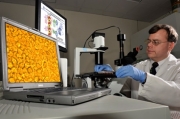There’s A Cure For That: A Look At New England’s Most Recent Medical Breakthroughs
Posted by erik devaney
Courtesy of mit.edu
The numerous medical and academic institutions of New England have played host to countless clinical advances throughout history. Examples of such advances include demonstrating the use of ether as a surgical anesthetic (Harvard, 1846); demonstrating the use of chemotherapy as a cancer treatment (Yale, 1942); and developing immunosuppression drugs for helping the body accept transplanted organs (Tufts, 1959). To this day, New England remains one of the leading regions for medical innovations in the country as well as the world.
Let’s see what our scientists have been up to lately…
Developing A Cure-All Drug For Viruses
Scientists from the Lincoln Laboratory at MIT have designed a drug that can identify and discriminately attack cells that are infected with a virus; and not just a specific type of virus… all viruses.
Whereas antibiotics, like penicillin, are effective against most bacterial infections, these drugs are relatively useless against viral infections. Enter the new MIT miracle drug. Scientists have tested the drug on 15 types of viruses and the drug has been effective against all 15. These viruses included H1N1 influenza (swine flu), a polio virus, a stomach virus, dengue fever and rhinoviruses, which cause the common cold. As senior staff scientist at MIT’s Lincoln Laboratory, Todd Rider, said of the drug, “In theory, it should work against all viruses.”
Synthesizing An Alzheimer’s-Fighting Compound
Yale University scientists have developed the first practical method for producing a natural, Alzheimer’s Disease-fighting compound in the lab. In addition to helping Alzheimer’s patients strengthen their memories, the breakthrough could potentially help patients who are suffering from the effects of exposure to chemical warfare agents.
Known as huperzine A, the compound is found naturally in the plant, Huperzia serrata, which is a species of Chinese moss. The compound acts as an enzyme inhibitor and has been used as a treatment for Alzheimer’s in China since the late 1990s. While previous methods for synthesizing the compound resulted in 2%-yields, Yale’s new method allows for yields of 40%. Being able to synthesize high quantities of huperzine A in the lab is essential because the Huperzia serrata plant “takes decades to grow and is nearing extinction due to overharvesting,” said Yale Chemist, Seth Herzon.
Diagnosing Cancer With A Simple Blood Test
MicroRNA "barcode," couresty of mit.edu
Instead of having to rely on MRIs and traditional, often uncomfortable, screening techniques, diagnosing cancer may soon be as simple as drawing blood.
Scientists at MIT have developed a new way to detect abnormal microRNA levels in the blood. Discovered about a decade ago, microRNA is a genetic material that turns genes on and off inside of cells. In cancer cells, microRNA functions erratically and contributes to the uncontrollable growth of tumors. MIT scientists can now employ tiny particles that latch onto specific types of microRNA. And since each type of cancer has its own microRNA signature, scientists can differentiate between — and diagnose — cancers with a higher degree of specificity. The only remaining challenge is that when it comes to a technique for detecting microRNA, “There’s not an accepted gold standard…Everybody has their own favorite one,” said MIT chemical engineering professor, Patrick Doyle.
Related posts:
- Doctors question Perry’s stem cell back treatment
- Connecticut Pharmaceutical Company Developing Oral Treatment For Type 2 Diabetes; Clinical Studies Start Next Year
- Suit Against Federal Stem Cell Research Dismissed
- So You’re About to Start Business School…Here’s Some Advice From a Recent Grad
- Blood Donations Urged Before Irene Arrives
Short URL: http://www.newenglandpost.com/?p=2916








